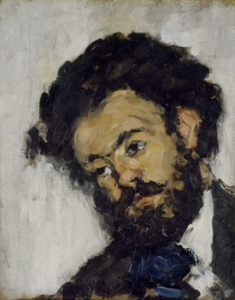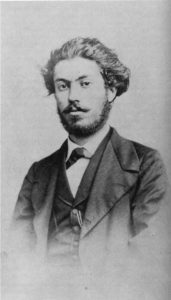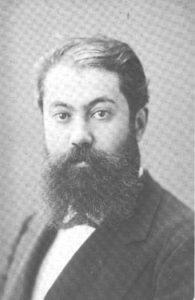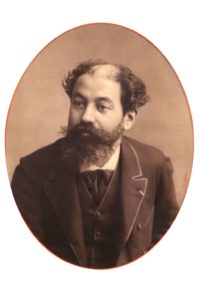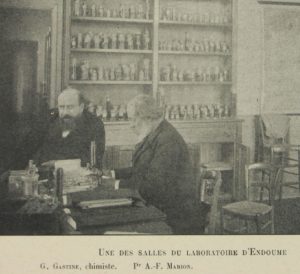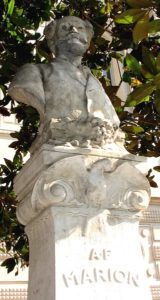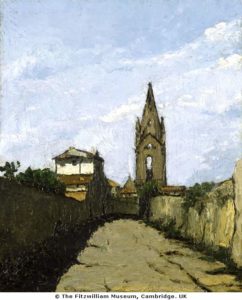R177 – Portrait d’Antoine-Fortuné Marion, vers 1871 (FWN424)
Pavel Machotka
(Cliquer sur l’image pour l’agrandir)
Dans une photographie de 1871, prise à peu près à l’époque où le portrait fut peint, Fortuné Marion a un visage lisse, ovale, avec une chevelure indomptée pour relever la sobriété de l‘ensemble. Dans le portrait, cependant, Cézanne peint la tête plus massive et granuleuse que sur la photo, avec des touches courtes empâtées qui rendent à la tête et aux cheveux le mouvement de la vie, et il incline fortement le tout. La question ne se pose pas de savoir quelle est la version la plus intéressante…
L’inclinaison de la tête est particulièrement troublante, si l’on voit le tableau comme une vraie pose, et inquiétante, si on considère l’inconfort de Marion ; mais je soupçonne qu’il nous faille le voir dans son organisation, et que si nous regardons l’inclinaison désinvolte de l’épaule, par exemple, nous percevrons la composition comme la superposition de trois pyramides stables, ce qui je crois était l’intention du peintre. L’épaule et la cravate forment la pyramide la plus basse (une imperceptible ligne blanche s’étire de la cravate jusqu‘au bord et complète la forme), la naissance des cheveux la deuxième, et le sommet de la tête la troisième, avec les sourcils angulaires faisant comme un écho plus doux ; la jonction du col et du revers devient alors une verticale stable qui aide à tenir la tête bien en place dans le cadre. Cet expédient semble assez radical pour figurer une tête sans intensité dramatique particulière, mais cela représente un compromis satisfaisant entre les exigences de la ressemblance, de l’expression et de la composition, et témoigne de la remarquable compréhension de la forme par Cézanne.
__________
In an 1871 photograph, taken at about the time the next portrait was painted, Fortuné Marion has a smooth, oval face with only a wild shock of hair to relieve the plainness. In the portrait, however, Cézanne paints the head more massive and lumpy, with short, full-paste strokes that make the head and hair alive with movement, and inclines the whole sharply. There is no question about which version is the more interesting.
The inclination of the head is particularly puzzling, if we look at the picture as representing an actual pose, and disquieting, if we consider Marion’s discomfort; but I suspect that we are to look at the picture formally, and that if we look at the rakish tilt of the shoulder, for example, we will see the composition as a superposition of three stable pyramids, which I believe was the intent. The shoulder and cravatte form the lowest one (a faint white line extending from the cravatte to the corner completes the shape), the hairline the second, and the top of the head the third, with the angular eyebrows a gentler echo; the juncture of collar and lapel then becomes a stable vertical helping hold the head in place well inside the frame. It seems a radical expedient for representing an undramatic head, but it represents a satisfactory compromise between the requirements of likeness, expression, and composition, and is witness to Cézanne’s insistent stress on form.
Source: Machotka, Cézanne: the Eye and the Mind.
Autres photographies de Marion :
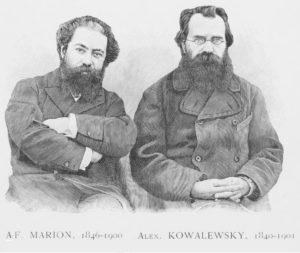
Antoine Fortuné Marion et Alexandre Kovalevski Respectivement Fondateur et Collaborateur des Annales du Musée d’Histoire Naturelle de Marseille

